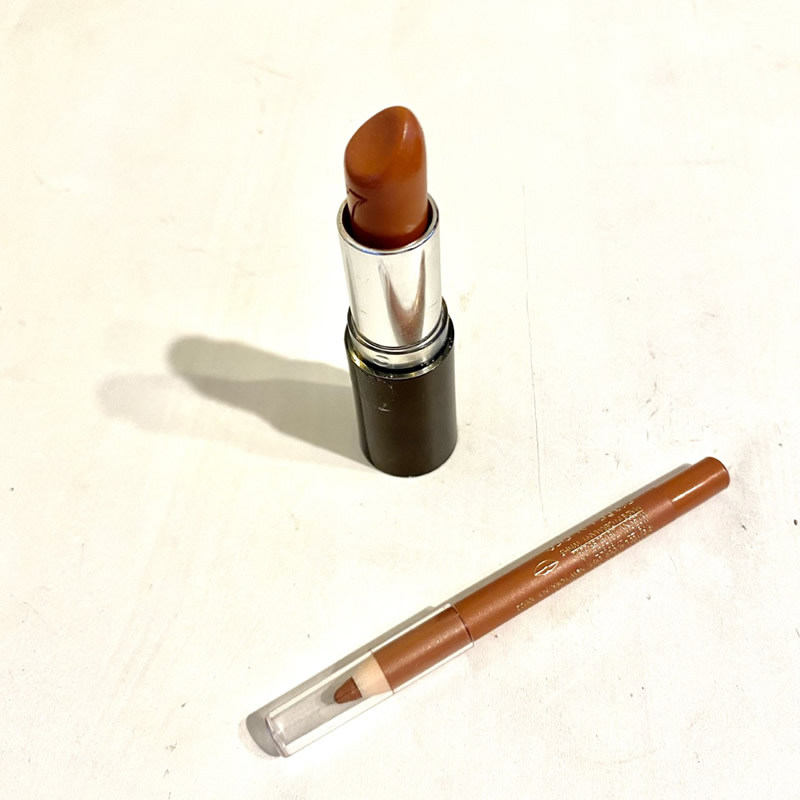Lipstick and Lip pencil - Lindsay J.


Description:
With only a moment's brushstroke, these simple everyday items can elevate me from the everyday to feeling special, sexy, and feminine. By accentuating my favourite bodily feature I can be transformed with confidence. It is an everyday item that represents a combination of power, choice, and sensuality.
Significance:
I chose this artifact because it demonstrates the ordinary in contrast to what society finds abnormal. Societal norms mean that a woman like me can purchase lipstick, and no one would think there was anything wrong with this. This is one way we can choose to feel more desirable. I chose this item precisely because of its common usage and acceptability. If I want to feel sexy, desirable, or flirtatious I can do so freely, but is it assumed that we all have a right to this? I would argue that it is not. We are conditioned to believe only certain people have this right, most commonly younger, attractive, cisgender, non-disabled people.
This item was chosen to open up a broader discussion on the lack of acceptance and accessibility to a range of experiences around sex and sexuality for people with a disability. Our heteronormative, ableist society allows certain groups to discuss and engage in flirtation, sex and pleasure. Any groups who do not fit into extremely strict and socially acceptable categories are subject to the policing of their behaviours, often confining individuals to “socially sanctioned categories” that may limit the freedom of expression for certain marginalised groups (Turner, Vernacchio & Satterly, 2018, p. 513). Shame stems from the constant weight of this unspoken judgement and silences those who may already be challenged by the barriers that exist for disabled people within a paternalistic, risk-averse, and ableist society.
Positionality:
The study of disability and sexuality and the intersections of these identifiers are interesting in relation to the field of social work due to the stigma and lack of conversation that is publicly had regarding this topic. Cultural discomfort still exists in this space, and particularly impacts women with a disability. Santos and Santos (2018) use feminist disability studies to support more than acceptance, but a cherishing of diversity. They consider how the oppression of disabled people is closely linked to the oppression of the body, particularly women’s bodies. Disabled women are commonly viewed through a biomedical lens and are consequently desexualised. The narrow lens through which society views who can engage in sexual narratives and activities means that many worldviews and experiences are under-acknowledged, or completely ignored. Furthermore, this is one of the myriad ways women’s bodies have been, and continue to be, controlled by others. This subject allows me to explore the intimate experiences of those who are often excluded from this discourse. By embracing the humanity in all people, we acknowledge sexual justice and sexual rights are equal and akin to social justice and human rights. This has challenged my thinking around where ableist ideas of sex and intimacy come from and opened my mind to the diversity of experiences and viewpoints of those often-overlooked voices. Some bodies can only be sexual in very limited ways and anything outside of this normative sexuality framework is ignored. Validating and exploring the many ways people experience their sexuality and bodies has opened my mind to becoming a more well-rounded practitioner.
Impact:
The gem I’m taking away is that sex and disability are heavily influenced by politics and culture and I appreciate now that my viewpoints have been shaped by the white, Western culture I grew up in. Fox and Bale (2018) found in their research that young people’s emergent sexualities are heavily influenced by popular culture, pornography and the neoliberal marketisation of sex. Disabled people are rarely represented in this space, and this constrains sexual diversity to a very limited subset of society. How can someone know how to get sex advice, experience their sexuality, or who to ask out on a date, without all these external factors creeping in and telling them that their thoughts are either right/acceptable, or wrong/stigmatised? Normalising this narrative and how we educate in this space is one way we can empower those who sit on the periphery of societal norms. For example, people with a disability, LGBTQI+ people, or those who are otherwise deemed unworthy to join in with the mainstream conversation on sex. By doing so, we see the whole person and all angles of their well-being. Reclaiming the narrative and normalising the conversation of sex and disability led to “crip theory” (Kafer, 2013) which argues for returning power to the disempowered, ensuring marginalised groups do not get excluded further. Social workers can give a platform to a person’s sexual voice, empowering them to gain knowledge and increase access to sexual information, or advocating for them when they cannot (Turner & Crane, 2015).
Wish List:
Lee, Fenge and Collins (2017) argue that sexual wellbeing is a global concern and that one’s assumptions and values must be explored if what we take for granted as truth is going to be challenged. Sexual justice and equity involve such things as allowing sexual education into our primary schools, abortion rights for all people, and sexual relationships support for people with intellectual disabilities. Believing in equity means also believing in issues of sexual justice. People’s beliefs are deeply rooted in how they were raised and what society tells us is acceptable, meaning anything that falls outside of these norms will leave room for polarisation of opinion. Societies that claim to be liberal are often far from it when sex is concerned. Viewers can take action to contribute to equitable societies through sexual justice by looking more deeply at the reasons why you hold the beliefs that you do. Ask yourself why you are embarrassed talking about menstruation, female orgasm, or masturbation. Think about where the feelings of shame or fear of certain subjects concerning sex come from. Watch your favourite television show more closely. Are the characters representative of society? Are the characters having sex all young and conventionally attractive? Thinking about who is left out of sexual discourse is vital to understand why our society is not liberal in its thinking or equitable in this space. Be curious and challenge what you might overlook. From here you are opening your mind to a more inclusive worldview.
Comments are closed.



One Comment
Lindsay, I really like how you have integrated lip pencil and lipstick to sexuality. It is interesting to read about how you convey the idea of lack of acceptance and accessibility regarding sexuality by the use of lip pencil and lipstick. The main issue when it comes to sexuality is the failure to recognize people with disabilities as sexual beings or cultural misconceptions in accepting diversity. Rather than their disability, the perspectives of non-disabled people towards individual with disabilities perpetuate the idea of desexualization by recognizing people with disabilities as asexual or unable to give consent (Shuttleworth, 2006). I think acceptance should be an essential factor when developing sexual identity because the fear of rejection might affect the individuals when expressing their sexual needs. Therefore, it conveys the idea that sexuality is shaped by social norms, culture and values.